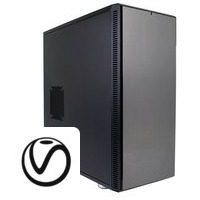Table of Contents
Introduction
Here at Puget Systems, specifically in the Labs department, most of the content that we write falls into one of two categories: either long, fairly in-depth articles looking at the performance of various PC components in a given application or recommended system pages, with multiple configuration options aimed at different budgets and lots of supporting data drawn from the aforementioned articles. For some readers all of that is information overload, though, and they just want a quick question answered: what is the best computer for my needs? We’re going to try answering that question more directly in a new series of short articles, like this one.
Today we are looking at V-Ray Next from Chaos Group, and specifically the CPU based side of this rendering engine. As applications go, it is very straightforward in its needs: CPU cores – lots of them! – and clock speed doesn't hurt either. These recommendations will also apply to older versions of V-Ray, as long as you are using the CPU processing side of things (we have another article for the GPU side).
Screenshot of V-Ray Next Benchmark
Good PC Configuration for V-Ray Next CPU
We'll start off with a good, solid workstation design for V-Ray Next – hopefully without breaking the bank. AMD has been killing it with high core count processors in the mainstream and workstation space recently, so you'll see a trend in this article that starts right here with their Ryzen 9 3950X. This is a 16-core processor that rivals the top of Intel's Core X line in rendering performance for a much lower price. To go with it, any good NVIDIA GeForce graphics card should do (consider a Quadro instead if you will be running any Autodesk software) and 64GB of memory ought to be plenty for most small to mid-size rendering projects. A fast SSD for the OS, applications, and project files rounds things out, and then a hard drive for storage of finished projects; don't forget to keep regular backups too!
| CPU | AMD Ryzen 9 3950X 16-core |
| Video Cards | NVIDIA GeForce RTX 2070 SUPER |
| RAM | 64GB DDR4 |
| Drives | 1TB NVMe SSD & 4TB SATA HDD |
Configure System With These Specs
Better PC Configuration for V-Ray Next CPU
Our most popular workstations for V-Ray Next CPU bump the processor up to AMD's Threadripper line, which offers even more cores while still maintaining good per-core performance. The 32-core 3970X is a solid choice here, without getting too expensive, and to go with that we'll double up the amount of RAM as well (though this can be increased or decreased, depending on your specific needs).
| CPU | AMD Threadripper 3970X 32-core |
| Video Cards | NVIDIA GeForce RTX 2070 SUPER |
| RAM | 128GB DDR4 |
| Drives | 1TB NVMe SSD + 4TB SATA HDD |
Configure System With These Specs
Best PC Configuration for V-Ray Next CPU
Maxing-out CPU rendering performance in V-Ray Next with this platform is as simple as bumping the processor up to AMD's top-end Threadripper 3990X. This 64-core behemoth is the fastest single CPU for rendering that we have tested to date, and beats out the highest-end dual-socket Xeon systems we have available as well (which feature up to 28 cores each).
| CPU | AMD Threadripper 3990X 64-core |
| Video Cards | NVIDIA GeForce RTX 2070 SUPER |
| RAM | 128GB DDR4 |
| Drives | 1TB NVMe SSD + 4TB SATA HDD |
Configure System With These Specs
That is the most powerful traditional, tower workstation that can be built for V-Ray Next CPU right now – though of course with the caveat that some folks may want more (or less) RAM or storage capacity, or might need a different GPU. There are also other ways to move beyond even this powerhouse of a PC. For example, if this were going to be a server-style system that was accessed remotely, you could go with a rackmount chassis and potentially dual or quad CPU configurations – though doing so drastically raises the price. V-Ray also supports distributed network rendering, so you could split out processing across several systems in either an office or server farm.
Additional Resources
If you want to know more about V-Ray Next performance, we have published several articles over the years looking at how individual CPUs compare. With video card speeds increasing at a faster pace than CPUs, and the option to stack several in a single workstation, you may also want to consider GPU-based rendering in V-Ray Next or another engine as well. And if you aren’t sure what you need, or if your workflow includes multiple applications, please feel free to call or email our consultants to get a more personalized configuration.
Puget Systems offers a range of powerful and reliable systems that are tailor-made for your unique workflow.

